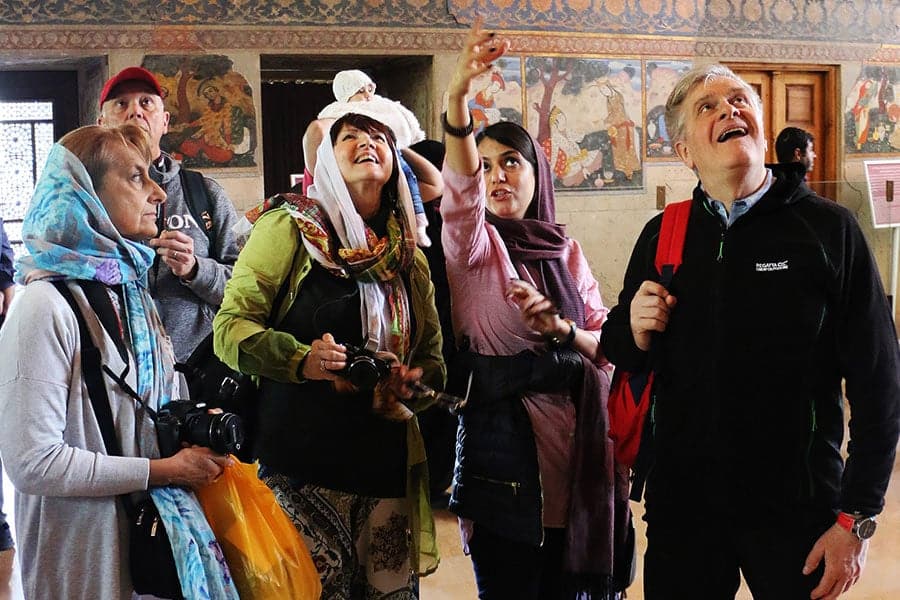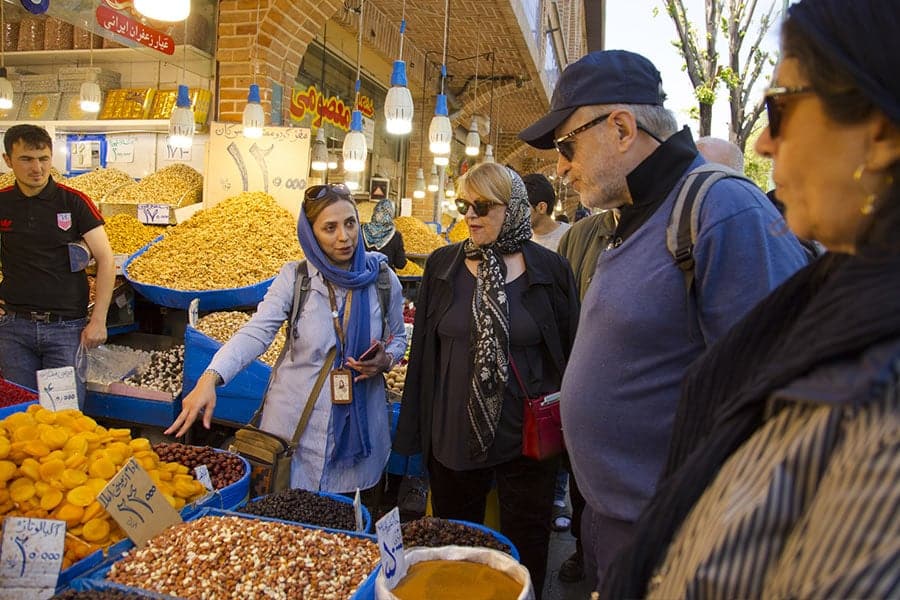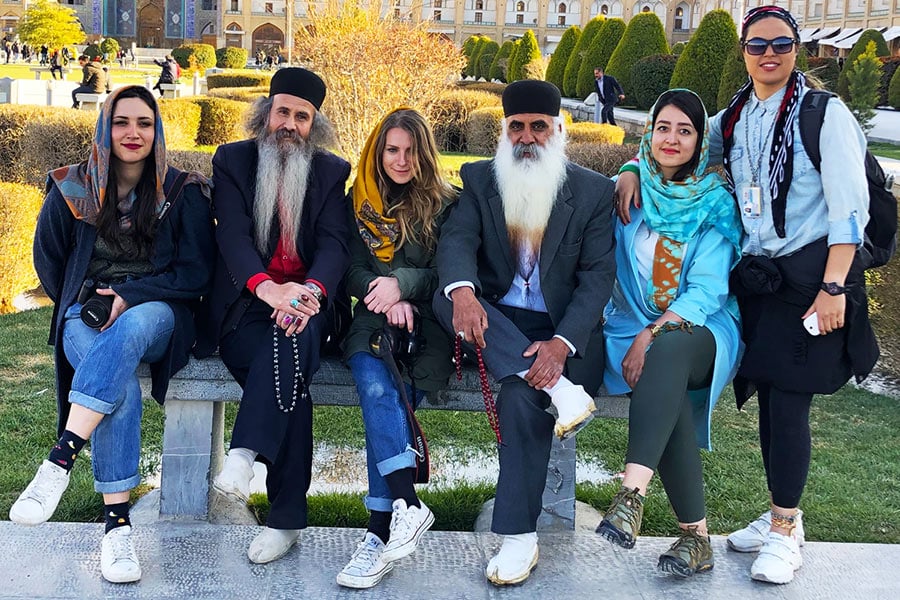Choosing your next travel destination among 196 nations can be quite a task, but Iran stands out with its exceptional attractions and destinations. Known for its rich history and cultural diversity, Iran ranks among the top tourist destinations due to its unique blend of attractions.
What are the must-see destinations in Iran?
This country offers a mix of vibrant cities, friendly locals, exquisite cuisine, and stunning architecture. Iran’s attractions are not just about its beautiful landscapes; its World Heritage Sites and striking desert vistas are equally captivating.
Contents
Iran Tourist Attractions
Each season in Iran presents a distinct experience, with a rich blend of historical and cultural elements, along with unique souvenirs. The country’s ancient heritage, cultural wealth, and varied natural and geographical features are widely acclaimed by visitors.
Iran’s diverse climate means that while some cities bask in summer-like warmth during winter, others enjoy milder spring or autumn conditions.
As a hub of diverse cultural sites and traditions from numerous nomadic groups, Iran offers an incredible array of both tangible and intangible heritage.
Plan your visit to explore Iran’s best attractions and destinations, delving into its rich culture, history, and natural beauty. Your adventure to one of Iran’s top sights awaits!
101 Popular Destinations in Iran
1. Persepolis in Shiraz (World Heritage Site)
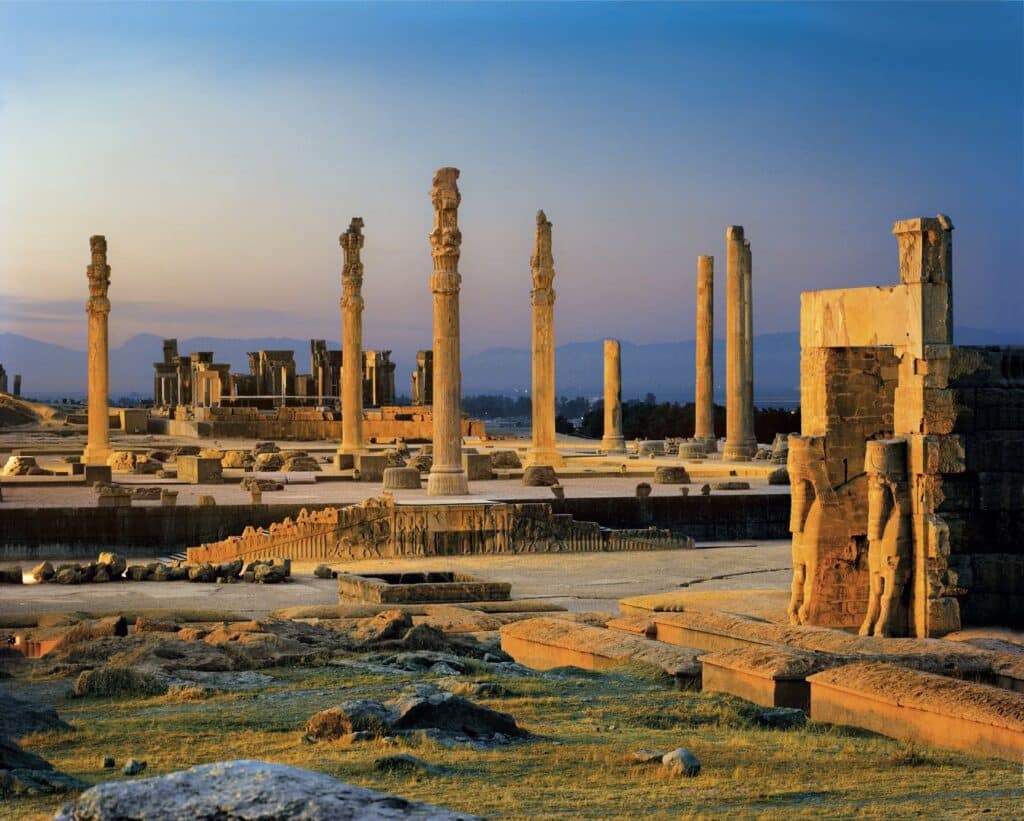
Persepolis, the ceremonial capital of the ancient Achaemenid Empire, stands as a testament to the grandeur and intricacy of Persian architecture. Located in the vibrant city of Shiraz, it’s a mesmerizing blend of history and art.
Each stone and carving tells tales of kings, battles, and the life of a civilization that once ruled a significant part of the ancient world. Tourists flock to this site, not just for its historical significance, but also for the panoramic views of the surrounding plains.
Read more: Iran Travel Guide
In the heart of Iran, Persepolis remains an emblem of the country’s rich past. Its majestic pillars, intricately designed reliefs, and the towering Gate of All Nations are a sight to behold.
The vastness of the site leaves many in awe, reflecting the might and vision of the Achaemenid rulers. Each visit feels like a step back in time, making it a must-visit for history enthusiasts and travelers alike.
It’s not just a site; it’s a journey through Iran’s illustrious history. Persepolis is among the best of Iran tourist attractions.
View Persepolis on Google Maps
2. Naqsh-e Jahan Square in Isfahan (World Heritage Site)

The Naqsh-e Jahan Square, often referred to as the ‘Image of the World’, is a masterpiece of urban design and architecture. Located in the heart of Isfahan, it’s surrounded by significant monuments from the Safavid era.
As you walk through the square, you’re transported to a time when Isfahan was one of the most important cities in the world. Dominated by the majestic Imam Mosque on the south, the Sheikh Lotfollah Mosque on the east, the entrance of the Grand Bazaar on the north, and the Ali Qapu Palace on the west, the square offers a 360-degree view of Isfahan’s cultural and historical grandeur.
The vast open space, often filled with locals enjoying picnics and traditional games, resonates with life and energy. It’s a living museum, showcasing the peak of Persian art and architecture. Every corner of the square tells a story, waiting to be discovered by those who tread its grounds. Isfahan is one of the top tourist attractions of Iran.
View Naqsh-e Jahan Square on Google Maps
3. Shah Mosque in Isfahan (World Heritage Site)

The Shah Mosque, also known as the Imam Mosque, stands majestically in Isfahan, exuding a captivating blend of spirituality and architectural splendor. With its iconic blue-tiled domes and minarets, the mosque is a remarkable representation of Persian architecture during the Safavid dynasty.
As you step inside, you’re greeted by awe-inspiring mosaics and calligraphy. The Shah Mosque is among Iran’s top tourist attractions.
Positioned at the southern end of the Naqsh-e Jahan Square, the Shah Mosque is more than just a place of worship; it’s a testament to the artistic and cultural zenith of Persia. The sunlit courtyard, the rhythmic patterns on the tiles, and the sheer scale of the structure make it a must-visit.
The tranquility within its walls offers a respite from the hustle and bustle outside, allowing visitors to immerse themselves in a meditative experience amidst its historical grandeur.
View Shah Mosque on Google Maps
4. Sheikh Lotfollah Mosque in Isfahan (World Heritage Site)

Sheikh Lotfollah Mosque, a gem in the crown of Isfahan, stands as an epitome of elegance and refinement. Distinct from other mosques in its lack of minarets and a smaller size, it boasts an unparalleled beauty that leaves visitors spellbound.
Commissioned by Shah Abbas I for the revered cleric Sheikh Lotfollah, the mosque’s design and color palette are intentionally subdued, yet every inch radiates sophistication.
Inside the mosque, the dome unfolds a mesmerizing dance of light and shadow, with its intricate patterns coming alive as the day progresses. It’s not just an architectural masterpiece; it’s a spiritual journey into the heart of Persian art and devotion.
This mosque, standing proudly on the eastern side of the Naqsh-e Jahan Square, beckons travelers to delve deeper into its history and artistry, and to lose themselves in its serene ambiance. When it comes to Isfahan’s most visited places, Sheikh Lotfollah Mosque is a standout.
View Sheikh Lotfollah Mosque on Google Maps
5. Ali Qapu Palace in Isfahan (World Heritage Site)

Dominating the western side of the Naqsh-e Jahan Square, the Ali Qapu Palace stands as a silent witness to the grandeur of the Safavid era in Isfahan. Initially serving as a gateway to the royal palaces, it eventually became a residence for Shah Abbas I. Its name, translating to ‘High Gate’, is a fitting description given its elevated stature and prominence.
The palace is a multi-storied wonder, with each floor boasting its unique features. As you ascend the palace, each level offers panoramic vistas of the square and the city beyond, culminating in a breathtaking view from the terrace.
With its intricate wooden ceilings, ornamental stuccos, and historically significant rooms, Ali Qapu is a treasure trove for history buffs and art enthusiasts.
It’s not just a palace; it’s a portal to a bygone era, echoing tales of royalty, art, and culture. A visit here offers a deep dive into the opulence and vision of the Safavid dynasty. Ali Qapu Palace ranks high on the list of Iran’s top tourist destinations.
View Ali Qapu Palace on Google Maps
6. Chehel Sotoun Palace in Isfahan (World Heritage Site)

Beyond a reflecting pool lined with tall plane trees, stands the Chehel Sotoun Palace. Its name, meaning “Forty Columns”, is derived from the twenty slender wooden columns supporting its entrance pavilion, which, when reflected in the waters of the fountain, appear to be forty.
Built during the Safavid era, the palace’s interior walls are adorned with large frescoes and paintings, depicting historical events and court life, providing a vivid window into Persia’s grand past.
The combination of the palace’s elegant architecture and lush gardens offers a serene escape in the midst of Isfahan. Chehel Sotoun Palace is among top tourist attractions in Iran.
View Chehel Sotoun Palace on Google Maps
7. Vank Cathedral in Isfahan

A fusion of Persian and Armenian architectural styles, the Vank Cathedral stands as a symbol of the Armenian community’s endurance in Isfahan. Built in the 17th century, the cathedral’s exterior is modest, but its interiors are a riot of colors with breathtaking frescoes, gilded carvings, and intricate tiles depicting biblical and historical scenes.
The cathedral’s complex also houses a museum, showcasing a rich collection of ancient manuscripts, artifacts, and chronicles of the Armenian history in Persia.
View Vank Cathedral on Google Maps
8. Si-o-se-pol Bridge in Isfahan

Spanning the Zayandeh River, the Si-o-se-pol (bridge) is not just a bridge but an architectural marvel and a popular gathering spot.
With its 33 arches, it’s the longest bridge in Isfahan and has been a cornerstone of the city’s infrastructure since the 17th century.
During the evenings, the bridge becomes a hub of activity with locals and tourists alike, coming together to enjoy the cool breeze, share stories, and listen to street musicians under its iconic arches.
View Si-o-se-pol Bridge on Google Maps
9. Zarch Qanat in Yazd (World Heritage Site)

Plumbing the depths of the earth, the Zarch Qanat in Yazd is a testament to ancient Persian engineering. This subterranean aqueduct, over 2,000 years old, is the longest qanat in Iran, ensuring the arid city of Yazd has a consistent water supply.
The cool tunnels, with their rhythmic arches, offer a refreshing escape from the desert heat above.
As you wander through, you’ll be reminded of the ingenuity and foresight of ancient civilizations, understanding their deep connection with the life-giving force of water.
View Zarch Qanat on Google Maps
10. Khaju Bridge in Isfahan

The Khaju Bridge stands as a monumental testament to Persian architecture and functionality. Spanning the Zayandeh River, this bridge, built in the 17th century, is much more than a mere passage; it’s a social hub, a place of gathering, and an artistic masterpiece.
With two tiers of arches, the bridge offers a symphony of stone, water, and history. At dusk, the soft glow from the bridge illuminates the waters below, creating an ethereal atmosphere that attracts both locals and tourists, eager to experience its charm and the melodic rhythm of flowing water.
View Khaju Bridge on Google Maps
11. Golestan Palace in Tehran (World Heritage Site)

In the bustling heart of Tehran, the Golestan Palace rises as a sanctuary of art, history, and grandeur.
As one of the oldest historic monuments in the city, it’s a dazzling display of ornate mirror work, majestic halls, and verdant gardens. This World Heritage Site, once home to Qajar monarchs, resonates with tales of opulence and Persian artistry.
The palace’s kaleidoscope of mosaic tiles, intricate frescoes, and shimmering chandeliers offers a captivating journey through Iran’s rich royal heritage.
View Golestan Palace on Google Maps
12. National Museum of Iran in Tehran

The National Museum of Iran is a treasure trove, a portal that transports visitors through millennia of Persian history. National Museum of Iran is one of the top places to visit in Iran.
Housing an impressive array of artifacts, from ancient pottery to inscribed tablets, this museum offers a comprehensive narrative of Iran’s cultural evolution.
Each exhibit, meticulously curated, tells tales of empires risen and fallen, of trade routes, and of artistic ingenuity. It’s not just a museum; it’s a chronicle of a civilization that has shaped the world in countless ways.
View National Museum of Iran on Google Maps
13. Azadi Tower in Tehran

A beacon of magnificence, the Azadi Tower rises gracefully, presiding over Tehran’s dynamic cityscape. This iconic monument, with its sleek, white-marbled exterior, captures the imagination of those who lay eyes upon it. The meticulous designs that grace its surface are a testament to Iran’s deep-rooted history, drawing from both pre-Islamic and Islamic architectural influences.
For those entering Tehran, this tower serves as a majestic introduction, signaling the profound cultural and historical journey awaiting them in the city. As the evening sun casts its golden hue, the tower gleams, offering a mesmerizing view that remains etched in the memories of countless travelers.
Every detailed carving, every arch, resonates with stories of a nation’s ambition and its enduring spirit. Beyond the initial awe of the Azadi Tower, Tehran presents a vibrant blend of tradition and modernity. Among Iran’s must-see places, Azadi tower is a prominent one.
View Azadi Tower on Google Maps
14. Eram Garden in Shiraz (World Heritage Site)

Eram Garden in Shiraz, where nature and Persian ingenuity coalesce. With its towering cypress trees, fragrant roses, and cascading fountains, the garden is a verdant paradise.
At its center stands the historic Qavam House, a picturesque mansion adorned with intricate tiles and paintings, reflecting the aesthetic ideals of the Qajar era.
Eram Garden is not just a place of beauty, but a testament to the Persian love for gardens and their deep-rooted symbolism in Iranian culture.
View Eram Garden on Google Maps
15. Nasir al-Mulk Mosque in Shiraz

Known as the ‘Pink Mosque’, the Nasir al-Mulk Mosque in Shiraz is a visual symphony of light and color.
Every morning, as the sun’s rays pierce its stained-glass windows, the mosque’s interiors transform into a vibrant canvas of kaleidoscopic patterns.
The dance of colors, combined with the intricate mosaics and carved pillars, creates an ambiance that’s both spiritual and mesmerizing. It’s not just a place of worship, but an ode to Persian art and craftsmanship.
For an unforgettable experience, visit Nasir al-Mulk Mosque in Shiraz, a top-notch Iranian attraction.
View Nasir al-Mulk Mosque on Google Maps
16. Pasargadae in Shiraz (World Heritage Site)

The ancient ruins of Pasargadae echo tales of Cyrus the Great and the mighty Achaemenid Empire. As the first dynastic capital of the Persian Empire, Pasargadae is home to a blend of majestic palaces, gardens, and the revered tomb of Cyrus.
The minimalist design of the tomb, standing solitary amid the vast landscape, speaks volumes of the great king’s legacy. A visit here is a journey back in time, tracing the footsteps of one of history’s most influential empires.
Pasargadae is a standout choice for travelers exploring Iran’s attractions.
View Pasargadae on Google Maps
17. Tomb of Hafez in Shiraz

Shiraz, the city of poets, is home to the Tomb of Hafez, a sanctuary dedicated to one of Persia’s most celebrated poets. The tomb, set within a serene garden, is a place of reflection and reverence.
Lovers of literature flock here to pay homage, drawing inspiration from Hafez’s verses that have touched souls for centuries. The evening’s gentle breeze, coupled with the soulful recitations of his poetry, offers a transcendent experience.
When in Iran, make sure to include Tomb of Hafez in your travel plans as truly it is one of the top attractions of Iran.
View Tomb of Hafez on Google Maps
18. Tomb of Saadi in Shiraz

Another gem in the poetic landscape of Shiraz is the Tomb of Saadi. Dedicated to the eminent poet Saadi, known for his profound insights on life and human nature, the mausoleum is an architectural beauty. Lush gardens surround the tomb, creating an atmosphere of tranquility.
The intricate tile work and the grand dome stand as symbols of the deep respect and love the Iranians have for their literary legends. Here, amidst the verses etched in stone, one can find solace and wisdom.
View Tomb of Saadi on Google Maps
19. Shushtar Historical Hydraulic System in Shushtar (World Heritage Site)

The Shushtar Historical Hydraulic System is a testament to ancient engineering genius. Located in Shushtar, this remarkable infrastructure has been in operation for nearly two millennia.
Designed during the Sassanian era, it comprises dams, tunnels, canals, mills, and waterfalls, harmoniously working in tandem.
Visitors are often left in awe of the ingenious solutions our ancestors devised to harness the power of water. Beyond its engineering marvel, the system has been pivotal in transforming the desert terrains into fertile grounds.
While it bears the marks of history, the system is still functional, a living relic that bridges the past and the present. Exploring this wonder, one gains a deeper appreciation for the relentless human spirit and the drive to innovate.
Shushtar Historical Hydraulic System in Shushtar is a prominent feature among Iran’s top tourist spots.
View Shushtar Historical Hydraulic System on Google Maps
20. Yazd Old City in Yazd (World Heritage Site)

Traversing through the alleys of Yazd’s Old City is akin to traveling back in time. With its iconic wind-catchers, mud-brick houses, and labyrinthine streets, this ancient city is a window to Persia’s glorious past.
As a UNESCO World Heritage Site, Yazd has managed to retain its architectural integrity and authentic charm. Every corner whispers tales of caravans that passed through, merchants bartering in bazaars, and craftsmen perfecting their art.
But what truly sets Yazd apart is its ability to adapt and thrive amidst the desert. Ingenious architectural designs provide natural air conditioning, making this city a desert jewel. As you wander, you’re bound to be captivated by the harmonious blend of history, culture, and innovation.
Yazd is a top choice among Iran’s tourist hotspots, So when in Iran, make sure to include this city in your travel plans.
View Yazd Old City on Google Maps
1. Jameh Mosque in Yazd
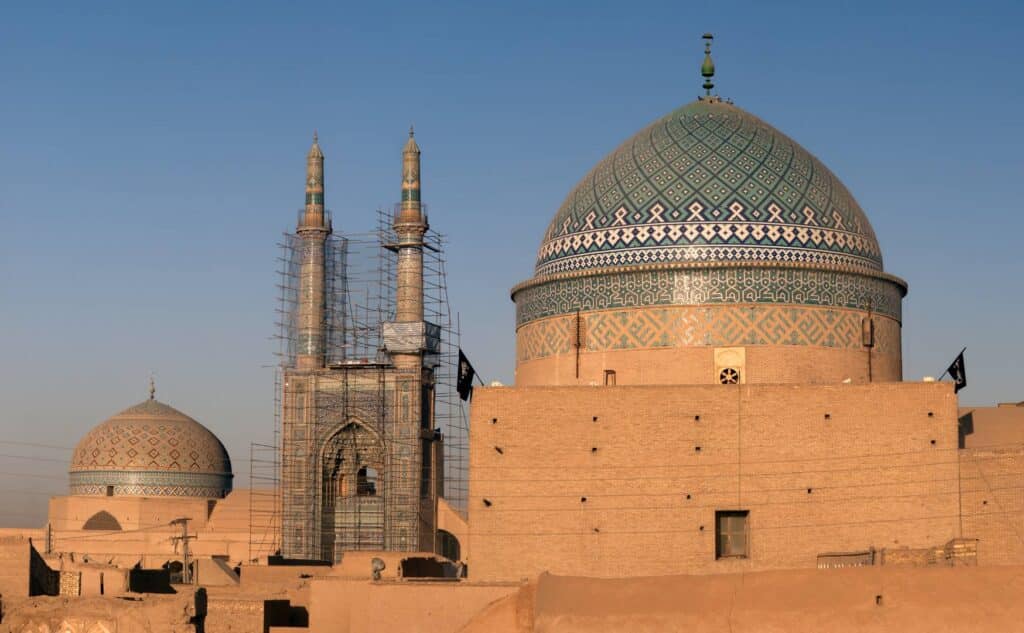
The Jameh Mosque of Yazd stands as a beacon of Persian architecture and spirituality. Its stunning minarets, which are among the tallest in Iran, pierce the skyline, drawing eyes and souls alike.
The portal’s intricate tile work showcases the zenith of Islamic art, with complex patterns and vivid colors narrating stories of faith and history. Stepping inside, one is embraced by a serene ambiance, amplified by the rhythmic play of light filtering through ornate windows.
The mosque has been a center of religious activity for centuries, and its energy is palpable. Whether you’re an admirer of architecture, a seeker of spiritual solace, or a history enthusiast, the Jameh Mosque promises a profound experience.
Among Iran’s must-see places, Jameh Mosque in Yazd is a prominent one.
View Jameh Mosque on Google Maps
22. Towers of Silence in Yazd

Perched on the outskirts of Yazd, the Towers of Silence, or ‘Dakhma,’ are solemn reminders of Zoroastrian funeral customs. These circular raised structures were once sites where the deceased were laid to rest, exposed to the elements and scavenging birds.
Though they might seem eerie, these towers underscore a profound respect for nature, ensuring the earth remains unpolluted by human remains.
The practice ceased in the 20th century, but the towers remain, standing sentinel against the desert backdrop. A visit here isn’t just about confronting mortality; it’s a journey into the depths of an ancient faith, understanding its rituals and appreciating its profound connection to nature.
View Towers of Silence on Google Maps
23. Zoroastrian Fire Temple in Yazd

A sacred flame that has burned for over 1,500 years is at the heart of the Zoroastrian Fire Temple in Yazd. This eternal flame symbolizes the undying spirit of Zoroastrianism, one of the world’s oldest religions.
Encased in a glass chamber, visitors can witness this ancient fire, which has been kept alive by devout priests through generations.
The temple itself, with its simple yet profound architecture, exudes an aura of serenity and reverence. Here, one can delve into the teachings of Zoroaster, exploring the tenets of good thoughts, good words, and good deeds.
A visit to this temple offers a rare glimpse into a faith that has withstood the test of time, still shining brightly in the modern world. Zoroastrian Fire Temple in Yazd is among Iran’s top tourist attractions.
View Zoroastrian Fire Temple on Google Maps
24. Chak Chak in Yazd

Chak Chak, a sacred Zoroastrian pilgrimage site, is dramatically perched on a mountainside. Legend has it that a princess, fleeing invaders, prayed here, and the mountain miraculously opened to shelter her.
Today, a steady trickle of water – believed to be her tears – drips from the mountain, giving the site its name. The sanctuary, with its evergreen tree and eternal flame, is a spiritual haven.
While the pilgrimage is particularly significant during the annual gathering, Chak Chak’s mystical ambiance can be felt year-round. Those who ascend its steps are often moved by the potent blend of nature, legend, and faith, making it a must-visit for those seeking spiritual enrichment.
25. Amir Chakhmaq Complex in Yazd

Dominating the heart of Yazd, the Amir Chakhmaq Complex is an architectural masterpiece.
This imposing three-story facade, with its symmetrical alcoves and soaring minarets, is a sight to behold, especially when illuminated at dusk.
While primarily known for its iconic structure, the complex also encompasses a mosque, a caravanserai, and a bathhouse.
The bustling square surrounding it is a hive of activity, with locals and tourists alike drawn to its charm.
Delve into the bazaars nearby, and you’ll discover a treasure trove of handicrafts, sweets, and textiles. The Amir Chakhmaq Complex isn’t just a monument; it’s the pulsating heart of Yazd, brimming with history, culture, and life. Discover the Amir Chakhmaq Complex in Yazd, as an iconic site in Iran’s tourism.
View Amir Chakhmaq Complex on Google Maps
26. Fin Garden in Kashan (World Heritage Site)

Lush greenery amidst desert landscapes, the Fin Garden in Kashan is an oasis of tranquility and beauty. This UNESCO World Heritage site, with its symmetrical layouts, terraced pools, and ornate pavilions, epitomizes Persian garden design.
As you stroll along its pathways, you’re treated to the soothing sounds of flowing water, a luxury in arid regions. Beyond its aesthetic appeal, the garden has witnessed significant historical events, adding layers of intrigue to its allure.
The combination of art, architecture, and nature creates a harmonious retreat, offering visitors a respite from the hustle and bustle. Fin Garden is a testament to human ingenuity, crafting paradise in the heart of the desert.
View Fin Garden on Google Maps
27. Borujerdis House in Kashan

The Borujerdis House, with its exquisite architecture and intricate stucco work, stands as a testament to Kashan’s rich heritage. Built during the Qajar era, this mansion showcases the zenith of Persian residential architecture. Its iconic windcatchers and stained-glass windows not only add aesthetic appeal but also serve functional purposes.
The house, with its interconnected courtyards and chambers, provides a glimpse into the lavish lifestyles of affluent merchants of yesteryears. The attention to detail, from ornate mirror work to delicate frescoes, makes this mansion a must-visit in Iran for history and art enthusiasts.
View Borujerdis House on Google Maps
28. Tabatabaei House in Kashan

Another jewel in Kashan’s architectural crown as premier tourist attractions in Iran., the Tabatabaei House, is a marvel of design and craftsmanship. Commissioned by a prominent carpet merchant, this house spans over 5,000 square meters, showcasing the grandeur of the Qajar era.
With its intricate wooden lattices, elegant stucco work, and serene courtyards, this mansion captures the essence of Persian elegance.
Each corner narrates tales of affluence, artistry, and ambition. A stroll through its corridors offers insights into the nuances of Persian art and culture.
View Tabatabaei House on Google Maps
29. Agha Bozorg Mosque in Kashan

A centerpiece of spiritual and architectural magnificence, the Agha Bozorg Mosque stands proudly in Kashan. Renowned for its symmetrical design, this mosque and theological school serves as a sanctuary for both worshippers and architecture enthusiasts.
Its central courtyard, adorned with azure tiles and sunlit patterns, exudes tranquility. The dome, with its intricate mosaics, crowns this edifice, making it a beacon of Islamic art and spirituality in the heart of Kashan.
View Agha Bozorg Mosque on Google Maps
30. Masouleh Village in Gilan

Perched on the slopes of the Alborz mountain range, Masouleh Village is a harmonious blend of nature and architecture.
With its terraced structures, rooftops serve as pedestrian pathways, creating a unique urban landscape.
Masouleh is a prominent feature among Iran’s top tourist attractions in Iran. The village’s houses, with their earthen hues, seamlessly merge with the verdant surroundings.
Masouleh’s age-old traditions, handicrafts, and local cuisine add layers of authenticity to this picturesque settlement. A visit here is a journey into the heart of Gilan‘s culture and heritage.
View Masouleh Village on Google Maps
31. Rudkhan Castle in Gilan
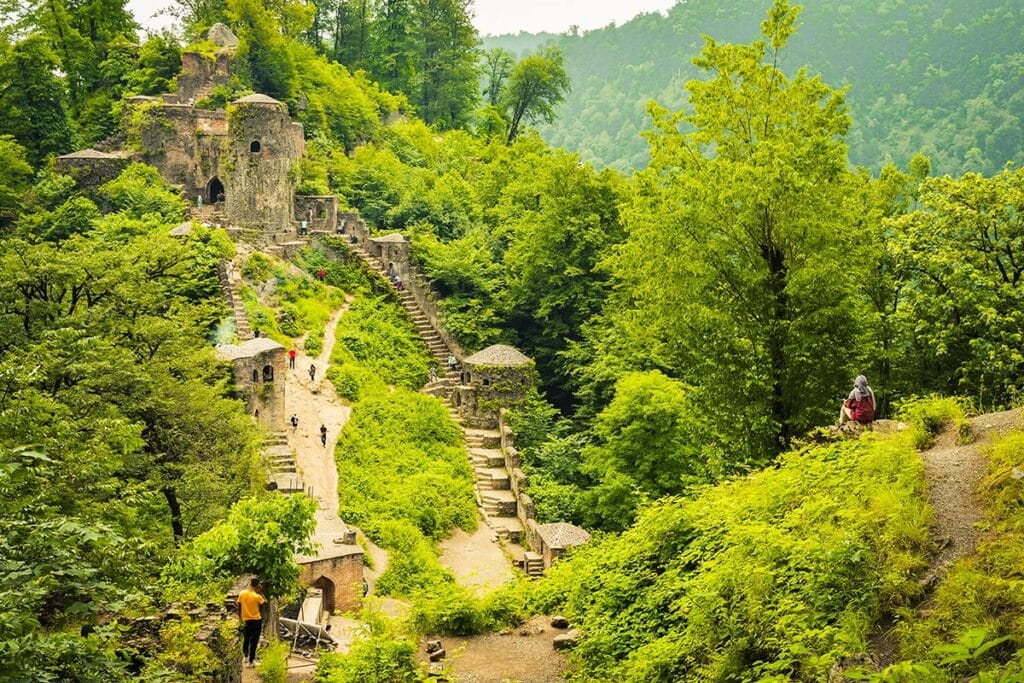
Rising majestically amidst dense forests, the Qale Rudkhan (Rudkhan Castle) is a fortress of mystery and might. Constructed during the Sassanid era, this stone fortress has withstood the test of time, serving as a bastion against invaders.
The trek to the castle, through verdant woods and cascading streams, is as enchanting as the fortress itself. With its battlements, watchtowers, and tales of valor, Rudkhan Castle transports visitors to a bygone era of knights and fortresses. Qale Rudkhan (Rudkhan Castle) is among top tourist attractions in Iran.
View Rudkhan Castle on Google Maps
32. Alamut Valley and Castle in Qazvin

Located in the rugged landscapes of the Alborz Mountains, the Alamut Valley and its iconic castle are steeped in history and intrigue. Once the stronghold of the Ismaili sect, Alamut Castle’s strategic location offered an impregnable defense.
The valley, with its breathtaking vistas and tales of the legendary ‘Assassins,’ captivates the imagination of every visitor.
Beyond its historical significance, the region is a haven for trekkers and nature enthusiasts, offering unparalleled views and experiences.
View Alamut Valley and Castle on Google Maps
33. Badab-e Surt Natural Springs in Sari

A mesmerizing dance of minerals and water, the Badab-e Surt Natural Springs are nature’s masterpiece. Cascading terraced springs, with hues ranging from azure to rust, create a surreal landscape.
The springs, rich in minerals, have carved out colorful basins over millennia. Set against the backdrop of golden mountains and clear blue skies, this natural wonder is a photographer’s dream and a traveler’s delight.
View Badab-e Surt Natural Springs on Google Maps
34. Mount Damavand in Tehran and Mazandaran

Towering over its surroundings, Mount Damavand is not just Iran’s highest peak but also a symbol of Iranian resilience and pride. This dormant volcano, with its snow-capped summit and legends of dragons, has inspired poets and artists for centuries.
For trekkers, the ascent offers challenges and rewards in equal measure, with panoramic views that are nothing short of spellbinding. Whether viewed from afar or up close, Damavand is a testament to nature’s grandeur.
View Mount Damavand on Google Maps
35. Rayen Citadel in Kerman (World Heritage Site)

Carved from mud-brick and stone, the Rayen Citadel is a living testament to the architectural prowess of ancient Persia. Spanning over 20,000 square meters, this fortress city boasts battlements, watchtowers, and residential quarters.
With its imposing walls and strategic location, Rayen has stood unyielding against both invaders and the ravages of time. A walk through its alleys is a journey into the heart of Kerman’s storied past.
View Rayen Citadel on Google Maps
36. Bam Citadel in Kerman (World Heritage Site)
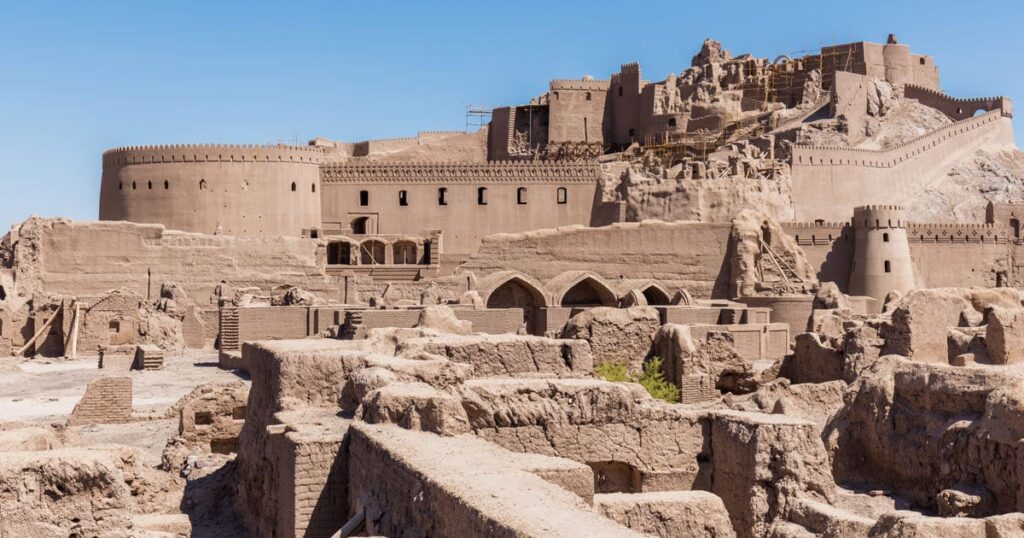
The echoes of a glorious past resonate through the ruins of Bam Citadel. Once the world’s largest adobe structure, this ancient city was a hub of trade, culture, and governance.
Though ravaged by time and a devastating earthquake, the Citadel’s remnants – from its fortifications to its marketplaces – offer insights into a flourishing civilization.
Restoration efforts are breathing life back into this UNESCO World Heritage site, making it a poignant reminder of the transient nature of human endeavors. Arg-e Bam is among standout choice for travelers exploring Iran’s attractions.
View Bam Citadel on Google Maps
37. Ganjali Khan Complex in Kerman
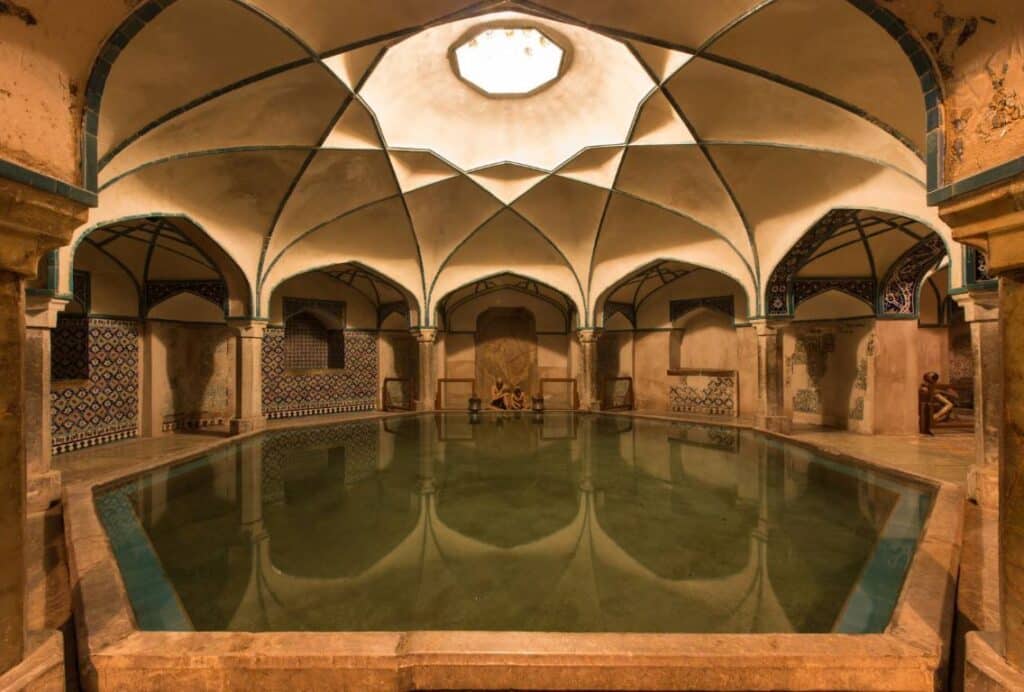
An epitome of Safavid architecture, the Ganjali Khan Complex is a microcosm of Kerman’s cultural and social life. Encompassing a caravanserai, mosque, bathhouse, and bazaar, this complex was commissioned by the governor Ganjali Khan.
The bazaar, with its arched ceilings and bustling stalls, pulsates with life, offering a myriad of handicrafts and delicacies. The bathhouse, now a museum, showcases the opulence of the era, with its intricate tile work and artistic frescoes.
View Ganjali Khan Complex on Google Maps
38. The Grand Bazaar of Kerman in Kerman

The Grand Bazaar of Kerman is where past meets present, where the whispers of ancient traders blend seamlessly with the lively chatter of today’s merchants. As you wander through its expansive alleyways, you’ll encounter a vivid array of colors and sounds, from the shimmering fabrics that catch the light to the melodic haggling of prices. The marketplace, with its origins in the Safavid era, stands as a testament to Iran’s enduring spirit of commerce and community.
Each stall, from those offering fragrant spices to those showcasing intricate handicrafts, tells a story of tradition, of families passing down their trade through generations. Venturing deeper into the bazaar, you’re introduced to majestic caravanserais and age-old teahouses. These spaces, once bustling with traders from distant lands, now serve as serene havens for visitors to rest and reflect.
Here, over a cup of traditional Persian tea, one can immerse oneself in tales of adventurers who once tread the same cobblestones, of empires that rose and fell, and of a city that has always thrived at the crossroads of culture and commerce. The Grand Bazaar of Kerman is not merely a marketplace; it’s a journey through time, an experience that bridges the gap between the legends of yesteryears and the vibrant realities of today.
View The Grand Bazaar of Kerman on Google Maps
39. Lut Desert in Dasht-e Lut and Kaluts (World Heritage Site)

The Lut Desert, a UNESCO World Heritage site, offers a breathtaking expanse of vast sand dunes, salt flats, and uniquely sculpted rock formations. Lut desert is a standout choice for travelers exploring Iran’s attractions.
Known to be one of the hottest places on Earth, its immense beauty is contrasted by its harsh conditions. The Kaluts, majestic sandcastle-like structures, rise from the ground, shaped by the relentless winds. A visit here is an adventure, a chance to witness nature’s raw power and surreal landscapes that seem almost otherworldly.
View Lut Desert on Google Maps
40. Tomb of Esther and Mordechai in Hamedan

Hamedan, a city steeped in antiquity, houses a monumental testament to interfaith unity: the Tomb of Esther and Mordechai. This revered site, considered a cornerstone of Jewish heritage in Iran, is an eloquent reminder of the enduring bonds between the Persian and Jewish communities.
As visitors approach the tomb, they are greeted by the sight of its elegant structure, adorned with intricate carvings and age-old Hebrew inscriptions, all of which narrate tales of devotion, bravery, and a shared history. Inside the mausoleum, the atmosphere is one of reverence and reflection.
The resting place of Esther and Mordechai evokes stories of their courage and influence during a crucial epoch in Persian history.
Visitors, irrespective of their religious affiliations, find themselves enveloped in a sense of serenity and a profound respect for the cultural amalgamation that the site represents. The tomb is not just a monument; it’s a bridge connecting diverse histories and a beacon of religious coexistence in Iran.
View Tomb of Esther and Mordechai on Google Maps
41. Alisadr Water Cave in Hamedan

The Alisadr Water Cave is a subterranean wonder in Hamedan.
As the world’s largest water-filled cave, it promises an enchanting boat ride through its crystal-clear waters and stunning rock formations. Illuminated stalactites and stalagmites reflect off the water’s surface, creating a mesmerizing dance of light and shadow.
The silence, broken only by the gentle ripples of water and echoing whispers, transports visitors to an ethereal realm, making the Alisadr experience truly magical.
View Alisadr Water Cave on Google Maps
42. Chogha Zanbil in Shush (World Heritage Site)

Chogha Zanbil stands as one of the best-preserved ziggurats outside Mesopotamia.
Built around 1250 BCE, this ancient Elamite complex in Shush is a marvel of ancient architecture and spiritual significance. Its grandeur, evident in its layered platforms and intricate inscriptions, speaks of a civilization deeply rooted in its beliefs and cosmology.
As the sun sets, casting golden hues over its bricks, Chogha Zanbil resonates with the whispers of a bygone era.
Chogha Zanbil is Must visit place and a prominent feature among tourist attractions in Iran.
View Chogha Zanbil on Google Maps
43. Takht-e Soleyman in Takab (World Heritage Site)

Takht-e Soleyman, or Solomon’s Throne, is a captivating archaeological site in Takab. This UNESCO World Heritage site was once a Zoroastrian sanctuary, with a fire temple that housed one of the three “Great Fires” in Zoroastrianism.
Encircled by mountains and centered around a serene lake, the ruins tell tales of rituals, royalty, and reverence. The site’s blend of mysticism, history, and natural beauty offers a holistic experience for every traveler.
When visiting Tabriz don’t forget to visit Takht-e Soleyman as it is among top tourist attractions in Iran.
View Takht-e Soleyman on Google Maps
44. Falak-ol-Aflak Castle in Khorramabad

Perched atop a hill in Khorramabad, the Falak-ol-Aflak Castle is a majestic fortress with a history spanning millennia. Its robust walls and twelve towers have withstood the test of time, bearing witness to the ebb and flow of empires.
Inside, the labyrinthine corridors and chambers house a museum showcasing the region’s rich heritage. The panoramic views from its battlements, encompassing the city and the winding river below, are truly a sight to behold.
View Falak-ol-Aflak Castle on Google Maps
45. Qeshm Island in Qeshm

Qeshm Island, the largest in the Persian Gulf, is a mosaic of natural wonders and cultural treasures. From its jagged coastal lines to its dense mangrove forests, Qeshm offers diverse landscapes waiting to be explored.
The island is also a haven for wildlife enthusiasts, with its protected areas teeming with rare species. Its bazaars resonate with the hum of local life, where traditional crafts and fresh seafood are aplenty.
A fusion of nature and culture, Qeshm promises an immersive experience for every traveler. When in Iran, make sure to include Qeshm Island in your travel plans.
View Qeshm Island on Google Maps
46. Valley of Stars in Qeshm

In the heart of Qeshm lies the Valley of Stars, a geological wonder sculpted by the forces of nature. Named for its otherworldly appearance, the valley is a maze of canyons, crevices, and towering formations that capture the imagination.
Legends speak of falling stars that carved out this landscape, adding to its mystique. As daylight fades and the night sky unveils a celestial display, the Valley of Stars truly lives up to its name, offering an ethereal stargazing experience.
View Valley of Stars on Google Maps
47. Hara Mangrove Forests in Qeshm (World Heritage Site)

The Hara Mangrove Forests of Qeshm are a unique ecological wonder, where the verdant mangroves rise from the salty waters of the Persian Gulf. This biosphere reserve is a haven for a diverse range of bird species, making it a birdwatcher’s paradise. The serenity of the waters, punctuated by the songs of birds and the gentle sway of the mangroves, offers a tranquil escape from the hustle and bustle. The interplay of marine and plant life in this delicate ecosystem is a testament to nature’s harmonious balance.
View Hara Mangrove Forests on Google Maps
48. Hormuz Island in Hormozgan
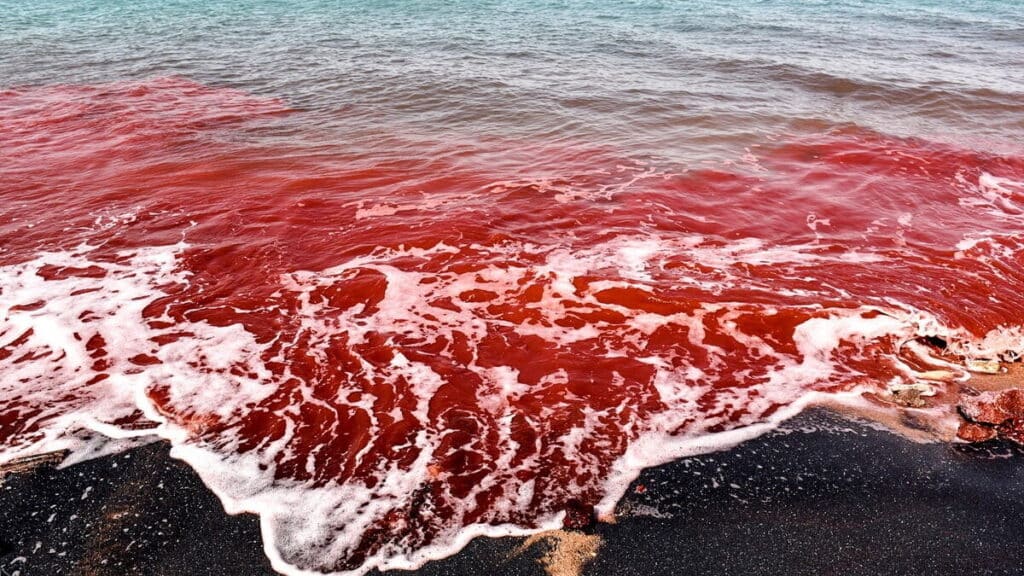
Hormuz or Hormoz Island, often referred to as the “Island of Colors,” is a geological marvel in Hormozgan. Its landscapes are a riot of colors, from red and orange soil to shimmering beaches with multi-hued sands. The island’s rich mineral deposits paint a vibrant palette that leaves visitors spellbound.
Beyond its natural wonders, Hormuz boasts a storied history of maritime significance. The juxtaposition of vivid landscapes and ancient relics makes the island an unforgettable destination. Hormuz is among top tourist attractions in Iran.
View Hormuz Island on Google Maps
49. Toghrol Tower in Rey

Toghrol Tower Tower is a magnificent architectural marvel that stands tall and proud in the heart of Ray, Iran. With its enchanting beauty and historical significance, this tower has become a symbol of Persian heritage and an important tourist attraction.
The history of Tower of Toghrol dates back to the Seljuk dynasty, specifically during the reign of Toghrul Beg, the founder of the dynasty. It was constructed in the 12th century and served as both a tomb and a minaret. The tower’s design is a perfect blend of Persian and Islamic architectural styles, showcasing the rich cultural heritage of the region.
As you approach the tower, you are immediately captivated by its grandeur. The tower stands at an impressive height, reaching towards the sky with its intricate brickwork and elegant proportions. The exterior of the tower is adorned with beautiful patterns and geometrical motifs, showcasing the expertise and craftsmanship of the artisans of that time.
View Toghrol Tower on Google Maps
50. Mashhad Imam Reza Shrine in Mashhad

In the heart of Mashhad stands the Imam Reza Shrine, a beacon of spiritual significance for Shia Muslims. This sprawling complex, with its golden dome and azure tiles, is not only an architectural masterpiece but also a place of deep devotion.
Pilgrims from around the world converge here to seek blessings and immerse themselves in its serene ambiance. The shrine’s intricate mosaics, rich history, and the air of reverence make it a profound experience, whether you’re a devout believer or a curious traveler.
View Mashhad Imam Reza Shrine on Google Maps
51. Sa’d Abad Museum Complex in Tehran

Set against the backdrop of the Alborz Mountains, the Sa’d Abad Museum Complex in Tehran is a cultural treasure trove. Once a royal residence, this expansive complex now houses several museums, each narrating a facet of Iran’s rich heritage.
From art collections and historical artifacts to the opulent palaces that echo tales of bygone monarchs, there’s a narrative waiting at every corner.
Stroll through its manicured gardens, and you’ll be transported to an era of Persian grandeur.
View Sa’d Abad Museum Complex on Google Maps
52. Niavaran Palace Complex in Tehran

The Niavaran Palace Complex, nestled in the northern part of Tehran, is a testament to Persian elegance and architectural brilliance. Once the last Shah’s residence, the complex offers a blend of traditional Iranian designs and modern aesthetics.
Its lush gardens, exquisite artwork, and intricate detailing transport visitors to a time of regal splendor. Beyond its beauty, Niavaran offers insights into Iran’s dynastic history, making it a must-visit for history enthusiasts and aesthetes alike.
View Niavaran Palace Complex on Google Maps
53. Milad Tower in Tehran

Dominating Tehran’s skyline, the Milad Tower stands as a symbol of modernity and progress. As the sixth tallest tower in the world, it offers panoramic views of the sprawling city below.
Its observation decks provide a unique vantage point, where the old and new facets of Tehran converge in a harmonious vista. Inside, the tower houses museums, galleries, and restaurants, making it a hub of culture and entertainment. By night, its illuminated facade adds a touch of brilliance to Tehran’s cityscape. Milad Tower is among top tourist attractions in Iran.
View Milad Tower on Google Maps
54. Tabriz Historic Bazaar Complex in Tabriz (World Heritage Site)
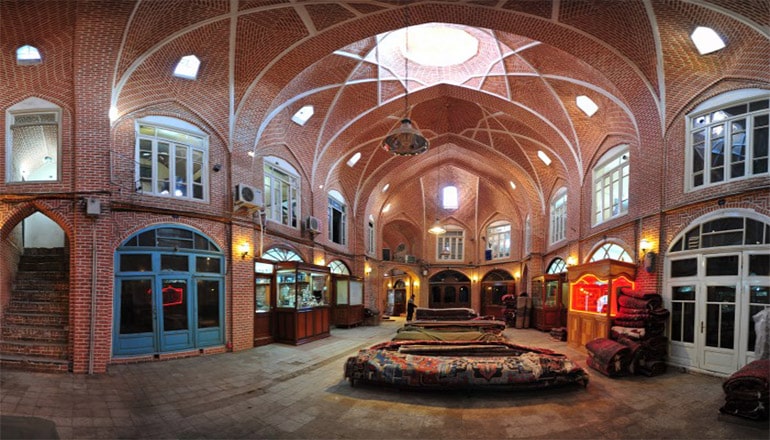
The Tabriz Historic Bazaar Complex is a labyrinth of interconnected alleys, domes, and caravanserais that pulse with life. Don’t miss out on The Tabriz Historic Bazaar, a significant site in Iran’s tourism.
Recognized as a UNESCO World Heritage site, this ancient bazaar has been a center of trade for centuries. The rich aroma of spices, the allure of Persian carpets, and the melodious haggling of traders create an ambiance that’s both vibrant and nostalgic.
Every nook and cranny tells tales of traders and travelers who once tread its paths, making the bazaar not just a marketplace, but a living museum of Persian culture and history.
View Tabriz Historic Bazaar Complex on Google Maps
55. Kandovan in Tabriz

Kandovan, located near Tabriz, is a captivating village renowned for its homes carved into rocky cliffs. These natural, volcanic formations have been inhabited for centuries, with modern comforts seamlessly integrated into ancient dwellings.
As you explore, you’ll discover the village’s unique charm, where life thrives within the heart of the rock, echoing tales of civilizations past. The organic architecture and timeless ambiance of Kandovan offer a journey through history and nature’s marvels. For travelers, Kandovan is an essential stop among Iran’s attractions.
56. Sheikh Safi al-din Mausoleum in Ardabil (World Heritage Site)

The mausoleum of Sheikh Safi al-din in Ardabil stands as a spiritual and architectural beacon. This UNESCO World Heritage site, with its intricate tilework and elegant domes, encapsulates the zenith of Islamic art and mysticism.
The mausoleum is not just a resting place for the revered Sufi leader but also a complex that showcases a rich blend of cultural and architectural heritage.
As you traverse its serene courtyards and art-laden chambers, the mausoleum offers a profound experience of Iran’s spiritual and artistic legacy.
View Sheikh Safi al-din Mausoleum on Google Maps
57. Maranjab Desert in Aran o Bidgol

The Maranjab Desert, located near Aran o Bidgol, unveils a vast expanse of golden sands and undulating dunes.
It’s a landscape where silence reigns supreme, broken only by the soft rustling of desert winds. As you venture deeper, you’ll discover the mesmerizing salt flats and the ancient Maranjab caravanserai, which stands as a testament to the desert’s historical significance along trade routes.
Whether you seek solitude or adventure, Maranjab promises an experience that resonates with the timeless allure of the desert. Maranjab ranks high on the list premier tourist attractions in Iran.
View Maranjab Desert on Google Maps
58. Bandar Abbas and the Persian Gulf in Hormozgan

Bandar Abbas, gracefully stretching along the shores of the Persian Gulf in Hormozgan, is a bustling port city with a rich maritime history.
As the gateway to the Hormuz Strait, this vibrant city seamlessly blends its trading past with modern-day vivacity.
The azure waters of the gulf, dotted with fishing boats and fringed by palm-lined promenades, offer a refreshing coastal charm. From its lively bazaars to the sun-kissed beaches, Bandar Abbas is a delightful blend of culture and natural beauty.
View Bandar Abbas and the Persian Gulf on Google Maps
59. Kish Island

Kish Island, shimmering in the turquoise waters of the Persian Gulf, is a haven of leisure and luxury.
With its pristine beaches, crystal-clear waters, and modern amenities, Kish stands apart as a premier destination for relaxation and recreation. Among Iran’s top picks, Kish holds a special place.
The island’s coral reefs teem with marine life, making it a diver’s paradise. Beyond its natural allure, Kish boasts ancient ruins, traditional bazaars, and upscale shopping centers. It’s a blend of the serene and the sophisticated, where tradition meets contemporary flair.
View Kish Island on Google Maps
60. Qavam House or Narenjestan-e Ghavam in Shiraz
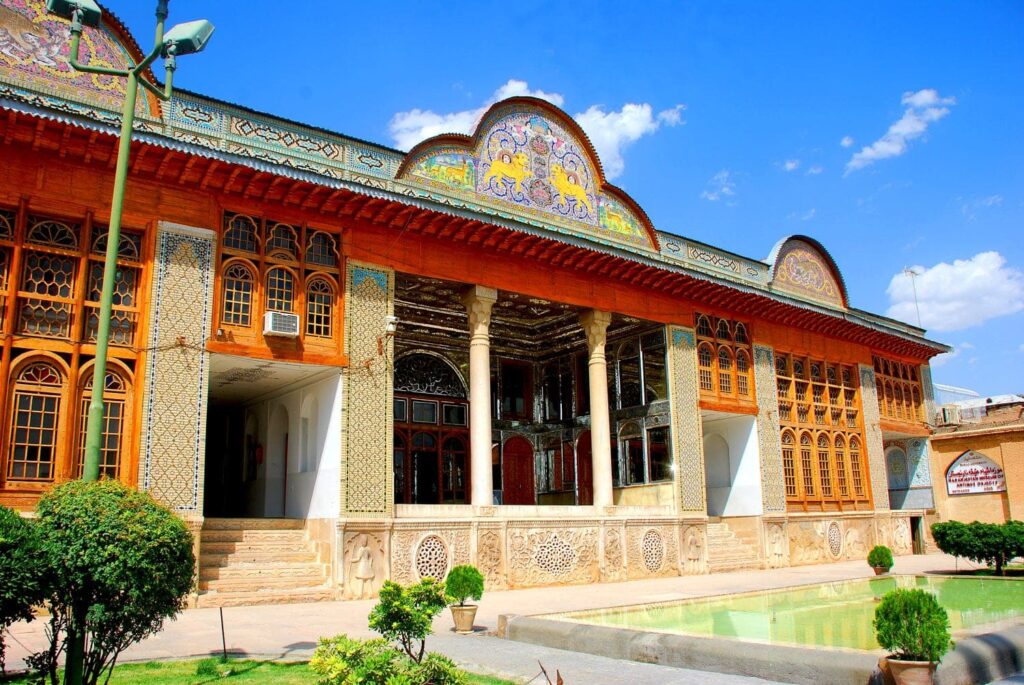
The Qavam House, also known as Narenjestan-e Ghavam, in Shiraz is an epitome of Persian elegance.
This 19th-century mansion, with its mirrored halls, intricate stucco work, and lush gardens, offers a glimpse into the opulence of the Qajar era.
The house is surrounded by serene gardens, where the fragrance of orange blossoms permeates the air. As you wander through its ornate rooms and verdant courtyards, the Qavam House transports you to a bygone era of grandeur and refinement.
View Qavam House or Narenjestan-e Ghavam on Google Maps
61. Garmeh in Isfahan

Garmeh, located in the heart of Isfahan province, is an oasis village that defies the arid deserts surrounding it. With its date palms, freshwater springs, and mud-brick houses, Garmeh is a testament to the resilience of life in the harshest of terrains.
The village’s age-old alleys echo tales of travelers and traders who sought refuge in its cool shade. Today, Garmeh beckons visitors with its rustic charm, warm hospitality, and the promise of tranquility amidst the vastness of the desert.
62. Dasht-e Kavir in Central Desert

The Dasht-e Kavir, also known as the Great Salt Desert, stretches across the Iranian plateau in a vast expanse of white salt flats, sand dunes, and desolate landscapes. This desert, one of the largest salt deserts in the world, is a realm of stark beauty, where the play of light and shadow on its undulating terrains creates mesmerizing vistas.
Despite its seemingly inhospitable conditions, the desert is home to unique flora and fauna, adapted to its extreme environment. A journey through Dasht-e Kavir is a dance with nature’s contrasts, where desolation meets life in its purest form.
View Dasht-e Kavir on Google Maps
63. Sultan Amir Ahmad Bathhouse in Kashan

The Sultan Amir Ahmad Bathhouse in Kashan is a masterpiece of Persian architecture and design. Dating back to the Safavid era, this historic bathhouse is adorned with intricate tilework, frescoes, and arches that reflect the opulence of the time. The play of light filtering through its stained glass windows creates a kaleidoscope of colors, casting a spellbinding glow on its interiors. Beyond its aesthetic appeal, the bathhouse offers insights into the social and cultural aspects of traditional Persian life. It’s a journey through history, art, and culture, all under one ornate roof.
View Sultan Amir Ahmad Bathhouse on Google Maps
64. Rasht And Rasht Bazaar

As Rasht is located near the shores of the Caspian Sea, this lush city benefits from an excellent climate that lets locals cultivate and harvest a wide range of fresh vegetables and fruits.
Rasht Great Bazaar bazaar is the heart of the economy in Gilan Province and is located in the old texture of Rasht. Rasht Bazaar dates back to the Safavid era (1501–1736). Unlike similar traditional bazaars, it is not covered and has no ceiling domes or lightwells. The bazaar has maintained its traditional appearance throughout the years and is still a place where agricultural products, different fish, local foods and handicrafts are sold. Among Iran’s top tourists attractions, Rasht holds a special place.
View Rasht Grand Bazaar on Google Maps
65. Gahar Lake in Lorestan

Gahar Lake, cradled amidst the Zagros Mountains of Lorestan, is a pristine jewel of nature. The lake, flanked by verdant forests and rugged peaks, offers tranquility in its purest form.
Its reflective waters mirror the surrounding beauty, creating a haven for nature enthusiasts and trekkers. Whether you camp by its shores or simply soak in the vistas, Gahar Lake promises a soulful communion with nature.
View Gahar Lake on Google Maps
66. Gonbad-e Kavus Tower in Golestan (World Heritage Site)

Towering over Golestan is the Gonbad-e Kavus, an architectural marvel that once served as a beacon for travelers. This 12th-century mausoleum boasts the world’s tallest brick tower and stands as a testament to the architectural prowess of the Khorasan region.
Its intricate geometric patterns and cylindrical form are emblematic of early Islamic design, making it a must-visit for history and architecture aficionados.
View Gonbad-e Kavus Tower on Google Maps
67. Tomb of Daniel in Shush

Shush is home to the revered Tomb of Daniel, a site of significance for multiple religions. This ancient tomb, with its conical roof and sacred chambers, is believed to house the remains of the biblical prophet Daniel.
Pilgrims and travelers alike are drawn to its spiritual aura, and the site stands as a symbol of religious harmony and shared heritage in the region.
View Tomb of Daniel on Google Maps
68. Firoozabad in Fars

Firoozabad, located in Fars, is a window into the grandeur of the Sassanid Empire. This ancient city boasts the impressive Ardeshir Palace, ruins of fire temples, and remnants of a bygone era. The city’s layout, with its concentric circles, showcases urban planning principles of the time. Steeped in history and surrounded by rugged landscapes, Firoozabad offers a journey through epochs of Persian civilization.
Among Iran’s top tourists attractions, Firoozabad holds a special place.
View Firoozabad on Google Maps
69. Tabriz Arg in Tabriz

The Tabriz Arg, or citadel, stands sentinel over Tabriz, echoing tales of dynasties and defenses. This historic fortress, with its imposing walls and strategic watchtowers, played a pivotal role in the city’s history. Today, it serves as a living museum, showcasing artifacts, weaponry, and narratives from the region’s turbulent past. A visit promises a blend of military architecture and historical insights.
View Tabriz Arg on Google Maps
70. St. Thaddeus Monastery in Qara Kelisa (World Heritage Site)

The St. Thaddeus Monastery in Qara Kelisa is a beacon of Armenian Christian heritage. Located amidst rolling hills, this ancient monastery is renowned for its unique black and white stonework.
It stands as a testament to centuries of faith, pilgrimage, and architectural evolution. Annually, it becomes a pilgrimage hub, drawing Armenian Christians to celebrate a historic mass, reinforcing its spiritual and cultural significance. Qara Kelisa stands out as a prime tourist attraction in Iran.
View St. Thaddeus Monastery on Google Maps
71. Kaboud Mosque in Tabriz

The Kaboud Mosque in Tabriz, also known as the Blue Mosque, is an epitome of Islamic art and architecture. Ravaged by earthquakes but partially restored, the mosque boasts intricate blue tilework that paints celestial patterns against its walls.
Every archway and dome tells tales of the 15th-century era, making it a mosaic of history and artistry. The Kaboud Mosque in Tabriz is a prominent feature among tourist attractions in Iran.
View Kaboud Mosque on Google Maps
72. Jameh Mosque in Isfahan (World Heritage Site)

The Jameh Mosque of Isfahan is an architectural masterpiece that spans over a millennium of Islamic design.
With its sprawling courtyards, iconic blue tiles, and a myriad of arches, it offers a panoramic view of Persian architectural evolution. The Jameh Mosque of Isfahan is among top tourist attractions in Iran.
Its lofty minarets and expansive prayer halls have borne witness to centuries of devotion, making it a spiritual and historical hub in the heart of Isfahan.
View Jameh Mosque on Google Maps
73. Jameh Mosque in Tabriz

The Jameh Mosque of Tabriz stands as a spiritual anchor in the city’s historic core.
With origins dating back to the 10th century, the mosque showcases a fusion of architectural styles, reflective of the dynasties that once graced this region.
Its prayer halls, adorned with calligraphy and geometric patterns, offer a serene space for reflection and devotion.
View Jameh Mosque on Google Maps
74. Carpet Museum of Iran in Tehran

The Carpet Museum of Iran in Tehran is a treasure trove of Persian artistry.
Housing an extensive collection of hand-woven carpets, the museum narrates the story of Iran’s rich textile heritage.
From tribal rugs to intricate city weaves, each piece is a testament to the craftsmanship and cultural narratives of its weavers. A visit offers a colorful journey through patterns, dyes, and history.
View Carpet Museum of Iran on Google Maps
75. Fathabad Garden in Kerman

Fathabad Garden in Kerman is a symphony of Persian landscaping and architecture. This historic garden, with its ornate pavilions and flowing water channels, embodies the principles of Persian garden design.
Surrounded by high walls and adorned with tall cypress trees, the garden is a serene retreat from the urban hustle.
Its pathways and porches offer a tranquil setting for reflection and leisure, making it a verdant gem in Kerman.
View Fathabad Garden on Google Maps
76. Narin Castle in Meybod

Rising from the heart of Meybod, Narin Castle stands as a sentinel of time.
This ancient adobe fortress, believed to be over two millennia old, offers a panoramic view of the surrounding town and desert. Its imposing walls and towers, weathered by time, whisper tales of dynasties, sieges, and trade routes. Exploring its labyrinthine chambers transports visitors to a bygone era of Persian history.
View Narin Castle on Google Maps
77. Bazaar-e Vakil in Shiraz

Bazaar-e Vakil in Shiraz is a vibrant testament to the city’s bustling trade and rich history. Established in the Zand era, this expansive bazaar is an intricate maze of shops, teahouses, and caravanserais. The air resonates with the hum of haggling, the aroma of spices, and the allure of Persian crafts. Its high arches and beautifully crafted corridors reflect the architectural brilliance of its time, making it a shopping experience steeped in history and culture.
View Bazaar-e Vakil on Google Maps
78. The National Jewelry Treasury in Tehran

Located within the Central Bank of Iran in Tehran, The National Jewelry Treasury is a dazzling showcase of jewels, gemstones, and royal regalia. Home to some of the world’s most exquisite and priceless pieces, including the famed Darya-e Noor diamond, this collection narrates tales of opulence, royalty, and craftsmanship. From bejeweled thrones to ornate crowns, every artifact is a chapter in Iran’s illustrious history. The National Jewelry Treasury in Tehran holds a special place as one of Iran’s top sights.
View The National Jewelry Treasury on Google Maps
79. Bisotun and Taq-e Bostan in Kermanshah (World Heritage Site)

The Bisotun and Taq-e Bostan sites in Kermanshah are a canvas of ancient artistry and inscriptions. Bisotun, a UNESCO World Heritage site, boasts a colossal bas-relief and cuneiform inscription detailing the victories of King Darius I.
Nearby, Taq-e Bostan impresses with its rock reliefs showcasing Sassanid kings in ceremonial and hunting scenes.
Together, these sites offer a riveting journey through epochs of Persian grandeur. isotun and Taq-e Bostan in Kermanshah is among top tourist attractions in Iran.
View Bisotun and Taq-e Bostan on Google Maps
80. Bazaar Reza in Mashhad

Bazaar Reza, located in the spiritual heart of Mashhad, is a bustling marketplace that thrives with devotion and commerce.
Adjacent to the Imam Reza shrine, this bazaar offers a plethora of religious artifacts, Persian crafts, and aromatic delicacies.
The melodic recitations, combined with the rhythmic cadence of trade, create an ambiance that is both spiritual and lively, making every visit an enriching experience.
View Bazaar Reza on Google Maps
81. Meybod Historical Caravanserai in Meybod

The Meybod Historical Caravanserai stands as a testament to the town’s significance along ancient trade routes. This well-preserved structure, with its robust walls and spacious courtyards, once offered refuge to weary travelers and merchants. Today, it serves as a vivid reminder of the days when caravans laden with goods traversed the vast deserts, seeking shelter under its welcoming arches.
View Meybod Historical Caravanserai on Google Maps
82. Reghz Canyon in Darab

Reghz Canyon in Darab is a geologic wonder, where nature’s forces have sculpted mesmerizing formations over millennia. The canyon’s walls, etched by wind and water, create a kaleidoscope of colors and patterns. As sunlight filters through, it paints a dynamic play of light and shadow, offering a visual spectacle that captivates every adventurer and nature lover.
View Reghz Canyon on Google Maps
83. Bagh-e Shahzadeh in Kerman (World Heritage Site)
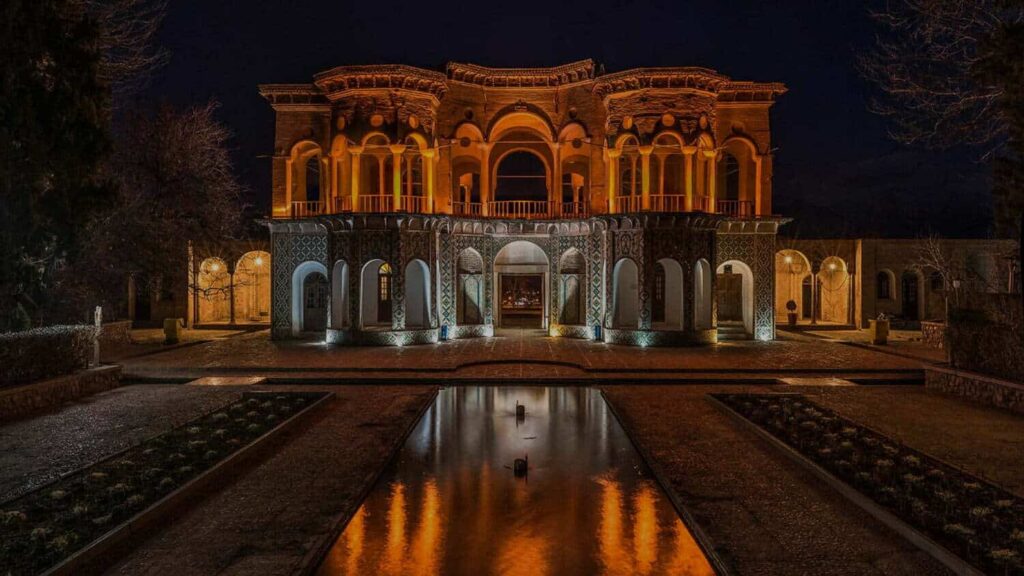
Bagh-e Shahzadeh, located in Kerman, is an oasis of tranquility and beauty. This Persian garden, with its cascading fountains, ornate pavilions, and lush flora, epitomizes the principles of traditional Iranian landscaping.
The harmonious interplay of architecture and nature offers a serene retreat, making it a verdant gem in the heart of the desert. Bagh-e Shahzadeh holds a special place as one of the top tourist attractions in Iran.
View Bagh-e Shahzadeh on Google Maps
84. Tappeh Sialk in Kashan

Tappeh Sialk, rising from the plains of Kashan, unveils layers of civilization dating back to the early settlements of the Iranian plateau.
This ancient ziggurat, with its terraces and relics, offers insights into the evolution of art, culture, and urban planning over millennia. Every excavation here has unraveled artifacts and stories, making Tappeh Sialk a treasure trove of archaeology and history.
View Tappeh Sialk on Google Maps
85. Tehran Grand Bazaar in Tehran

The Tehran Grand Bazaar is more than just a marketplace; it’s a vibrant chronicle of the city’s history and its ever-evolving identity. As one navigates through its labyrinthine corridors, there’s an immediate immersion into the city’s soul.
The air is thick with the aroma of saffron and turmeric, while the shimmer of handcrafted jewelry competes for attention with the soft allure of meticulously woven Persian rugs. Each stall, each vendor, tells a unique story, echoing the legacy of traders who have been the lifeblood of this bazaar for centuries. But amidst the traditional, there’s also a hint of the contemporary.
Amidst stalls laden with handcrafted artifacts, you’ll find modern boutiques showcasing the latest in fashion and technology, a testament to Tehran’s ability to balance its rich heritage with the demands of the modern world. As you pause for a moment, sipping tea from one of the many bustling teahouses, you realize that the Tehran Grand Bazaar is not just a place for commerce.
It’s a living, breathing entity that captures the essence of Tehran, reflecting its past, celebrating its present, and looking forward to its future. Discover the allure of Tehran Bazaar, an iconic tourist attractions in Iran.
View Tehran Grand Bazaar on Google Maps
86. Bagh-e Dolat Abad in Yazd (World Heritage Site)

Bagh-e Dolat Abad in Yazd is a testament to Persian artistry and ingenuity. Renowned for having Iran’s tallest windcatcher, this garden showcases a harmonious blend of water channels, shade trees, and elegant pavilions.
Designed for respite in the desert’s heat, its cooling architecture and serene ambiance make it a haven of relaxation and reflection. Bagh-e Dolat Abad is among top tourist attractions in Iran.
View Bagh-e Dolat Abad on Google Maps
87. Abyaneh Village in Kashan

Abyaneh, often referred to as the “Red Village,” is a historic gem nestled in the foothills near Kashan.
Known for its terracotta-hued mud-brick houses, winding alleys, and traditional attire worn by its people inhabitants, Abyaneh offers a nostalgic journey into Iran’s pastoral past.
Every corner of this terraced village whispers tales of traditions and timelessness.
View Abyaneh Village on Google Maps
88. Bazaar of Kashan in Kashan

The Bazaar of Kashan is not just a marketplace but a living testament to the city’s storied past and dynamic present.
Every step taken within its confines feels like a journey through time, as the intricacies of Persian architecture envelop visitors.
The beautifully crafted domes capture the sunlight, casting a warm glow on the stone pathways below, while the majestic caravanserais stand as silent witnesses to the countless traders and travelers who have sought refuge within their walls over the centuries.
Each vendor within the bazaar adds a unique chapter to its narrative. The scent of aromatic spices wafts through the air, leading one to stalls brimming with saffron, cinnamon, and cardamom.
A few steps away, artisans showcase their skill, weaving textiles with patterns passed down through generations. The hum of conversation, the rhythm of daily commerce, and the array of colors and textures create a sensory mosaic that embodies the essence of Kashan.
For any traveler seeking to truly understand the heartbeat of this historic city, a visit to its bazaar is an experience that resonates long after one departs its echoing corridors.
View Bazaar of Kashan on Google Maps
89. Dizin Ski Resort in Tehran

Dizin Ski Resort, located north of Tehran, is a winter wonderland set against the majestic Alborz Mountains. Renowned for its powdery slopes and modern facilities, Dizin beckons skiers and snowboarders from around the globe. With trails catering to all skill levels and a snow season that lasts longer than most, it’s a hub of winter sports and alpine beauty.
View Dizin Ski Resort on Google Maps
90. Naranjestan Qavam in Shiraz

Naranjestan Qavam, located in the heart of Shiraz, is a testament to 19th-century Persian elegance. This historic mansion, with its mirrored halls, intricate tilework, and lush gardens, is a reflection of the opulence of the Qajar era. Every detail, from its ornate ceilings to its verdant courtyards, speaks of artistry and refinement.
View Naranjestan Qavam on Google Maps
91. Haft Tepe in Khuzestan
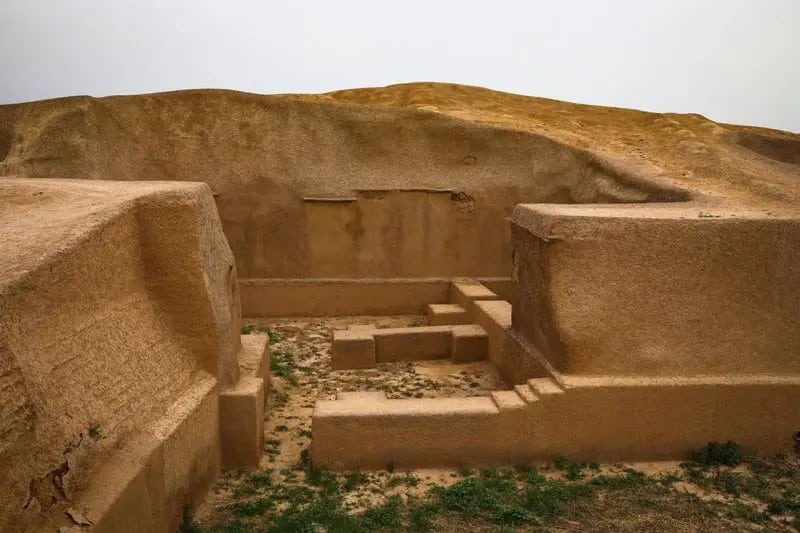
Haft Tepe, situated in Khuzestan, is an archaeological treasure trove. This ancient Elamite site, with its tombs, temples, and inscriptions, offers insights into a civilization that thrived over 4000 years ago. The excavations here have revealed artifacts, relics, and structures that narrate tales of royal rituals, governance, and daily life.
92. Manar Jonban in Isfahan

Manar Jonban, or the “Shaking Minarets” in Isfahan, is an architectural marvel. This 14th-century mausoleum is famed for its unique phenomenon: when one minaret is shaken, the other oscillates in unison. Beyond its intriguing physics, the mausoleum boasts exquisite tilework and intricate designs that exemplify Islamic artistry.
View Manar Jonban on Google Maps
93. Karim Khan Citadel in Shiraz

Dominating the landscape of Shiraz is the robust Karim Khan Citadel. Built during the Zand dynasty, this fortress, with its towering battlements and circular towers, was both a royal residence and a stronghold. Today, it stands as a monument to Shiraz’s historical significance and architectural prowess, inviting visitors to explore its chambers, courtyards, and tales of yore.
View Karim Khan Citadel on Google Maps
94. Soltaniyeh Dome in Zanjan (World Heritage Site)

The Soltaniyeh Dome in Zanjan, a UNESCO World Heritage site, is an epitome of Mongol architecture. With its turquoise-blue tiles and soaring structure, it stands as one of the largest brick domes in the world. The mausoleum, built in the 14th century, is a harmonious blend of Persian and Mongol design, making it a masterpiece of architectural innovation. Don’t miss out on The Soltaniyeh Dome in Zanjan, a significant site in Iran’s tourism.
View Soltaniyeh Dome on Google Maps
95. Bishapur and Tang-e Chogan in Kazerun

Bishapur, near Kazerun, unveils remnants of a once-thriving Sassanid city. With its rock reliefs, ancient ruins, and the nearby Tang-e Chogan gorge, Bishapur is a canvas of art and history. The bas-reliefs in Tang-e Chogan narrate tales of Sassanid victories, while the city’s remnants speak of daily life, commerce, and grandeur.
View Bishapur and Tang-e Chogan on Google Maps
96. Tabiat Bridge in Tehran

The Tabiat Bridge, stretching across Tehran, is more than just a pedestrian overpass. This multi-level bridge, adorned with green spaces and seating areas, offers a serene escape amidst the city’s hustle. Connecting two parks, it’s a hub of leisure, offering panoramic city views, eateries, and a blend of architecture and nature.
View Tabiat Bridge on Google Maps
97. Iran Holy Defense Museum in Tehran

The Iran Holy Defense Museum in Tehran is a poignant tribute to the sacrifices made during the Iran-Iraq war. Through a series of exhibits, dioramas, and memorabilia, the museum offers a comprehensive insight into the war’s events, heroes, and impact. It’s a place of reflection, remembrance, and understanding, shedding light on a pivotal chapter in Iran’s history.
View Iran Holy Defense Museum on Google Maps
98. Babak Fort in Kaleybar

Perched atop a mountain in Kaleybar, the Babak Fort stands as a symbol of resistance and resilience. This ancient fortress, associated with the legendary leader Babak Khorramdin, offers breathtaking panoramic views of the surrounding valleys and peaks.
Its ruins, shaped by battles and time, are a testament to the indomitable spirit of those who defended its walls.
View Babak Fort on Google Maps
99. Meymand in Kerman (World Heritage Site)

Meymand, a troglodyte village in Kerman, is a marvel of human adaptation. This UNESCO World Heritage site, with its hand-carved rock dwellings, has been inhabited for thousands of years. The village offers a unique glimpse into a way of life that has harmoniously coexisted with nature, making it a captivating journey into history and human ingenuity.
BOOK ONLINE
Tehran Hotels
100. Shahr-e Sukhteh in Sistan and Baluchestan (World Heritage Site)

Shahr-e Sukhteh, or the “Burnt City,” is an archaeological wonder in Sistan and Baluchestan. Dating back to the Bronze Age, this ancient city offers insights into early urban life, trade, and culture. With its intricate artifacts, seals, and remnants, Shahr-e Sukhteh is a testament to the complexities of ancient civilizations and their legacy.
View Shahr-e Sukhteh on Google Maps
101. Palangan Village in Kurdistan

Palangan Village in Kurdistan is a picturesque testament to harmony with nature. Cascading down a steep hillside, the stone houses of Palangan are built atop one another, creating a terraced effect. The meandering river below and the traditional lifestyle of its inhabitants add to the village’s rustic charm, making it a serene escape from the modern world.
